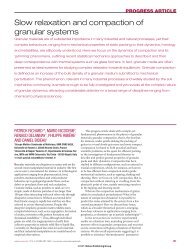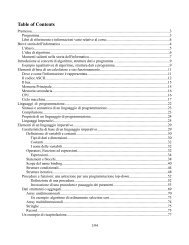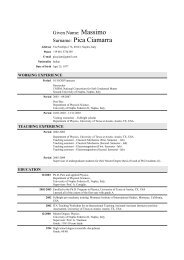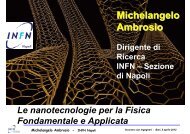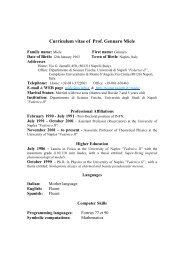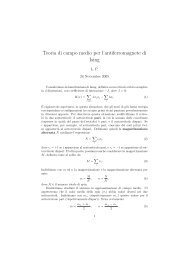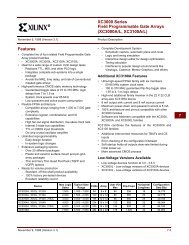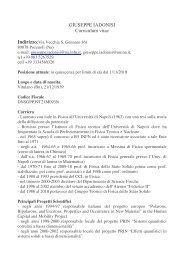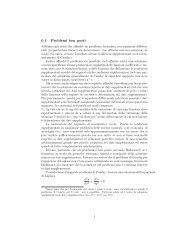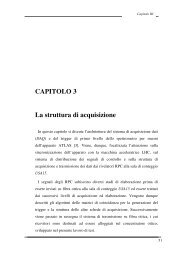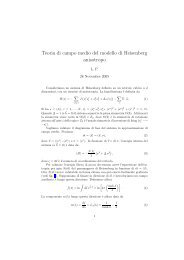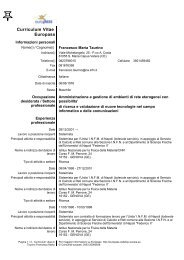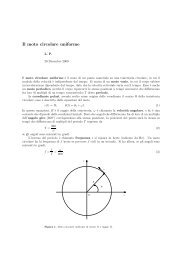Phys Rev E
Phys Rev E
Phys Rev E
Create successful ePaper yourself
Turn your PDF publications into a flip-book with our unique Google optimized e-Paper software.
MANZO et al. PHYSICAL REVIEW E 73, 051707 2006<br />
FIG. 2. Sequence of photograms showing the light-induced rotation<br />
of a LC droplet in time, as highlighted by the revolution of a<br />
dragged small object. Scale bar: 1 m.<br />
First, using the crossed-polarizers geometry we could image<br />
the birefringence rotation, corresponding to the director motion,<br />
as a periodic pattern modulation in time. For the smallest<br />
droplets, we could observe a significant modulation of<br />
light intensity during the rotation even without the analyzer,<br />
presumably due to the anisotropic scattering cross section of<br />
the droplets. Second, we could also measure the droplet fluid<br />
rotation i.e., regardless of director rotation when a smaller<br />
satellite droplet or another small object happened to get<br />
trapped close to the rotating droplet and was thereby dragged<br />
around, as in the case shown in Fig. 2. The rotation speed<br />
measured in these two ways when the satellite was sufficiently<br />
small and close to the rotating droplet was always<br />
found to be the same.<br />
In order to check if the photoinduced effects give rise to a<br />
rotation speed enhancement, on each droplet we measured<br />
the rotation frequency induced by the He-Ne and the IR<br />
beams as a function of input beam polarization ellipticity. We<br />
repeated this for many different droplets having a range of<br />
diameters. We also measured the rotation frequencies induced<br />
in pure undoped liquid crystal droplets, although of<br />
course in this case the comparison could not be done with<br />
exactly the same droplet sizes. In all these measurements, the<br />
two laser beams were adjusted for having a roughly equal<br />
angular momentum flux, as given by Eq. 20. In particular,<br />
the light power measured after the microscope objective was<br />
about 4.1 mW for the He-Ne beam and 2.8 mW for the IR in<br />
most data shown. These values correspond, for a given polarization<br />
ellipticity s3, to the same angular momentum flux<br />
em −18 to within 15% Mz0 =1.3±0.110 N m for the case of<br />
circular polarization. However, we also investigated the<br />
power dependence of the rotation frequency in some droplets.<br />
An example of the measured rotational frequencies of a<br />
given droplet versus light polarization ellipticity given by<br />
the angle is shown in Fig. 3. We actually measured this<br />
dependence for many other droplets of different sizes, made<br />
of both pure and dye-doped LC. Each of these measurements<br />
was then fitted by means of Eq. 26. In these fits the radius<br />
R was fixed at the value determined by analyzing the droplet<br />
microscopic picture. The absorbance at 633 nm was instead<br />
measured separately on a bulk sample we obtained 0 =1.0±0.2103 cm−1 and then kept fixed to this value in<br />
all fits. The constants f0 and were adjusted for best fit. f0 051707-10<br />
FIG. 3. Droplet rotation frequency f vs input light ellipticity<br />
angle , for a dye-doped LC droplet having a radius of 2.4 m,<br />
using the IR a or He-Ne b laser beams, with a power of 2.8 and<br />
4.1 mW, respectively. The dots are the measured values and the<br />
solid line is the theoretical fit based on Eq. 26. The threshold<br />
ellipticity t is obtained from the fit from the two symmetrical<br />
points at which the solid line crosses zero.<br />
was found to be roughly consistent to within a factor of 2<br />
in most cases with its predicted value, as given by Eq.<br />
27 using the known or measured values of the laser power<br />
and frequency, water viscosity, and droplet radius. From<br />
the best-fit value of , we could also estimate the birefringence<br />
n, which was almost always found to fall in the<br />
range 0.11–0.13 average 0.12, with a few droplets giving<br />
a value of 0.10 and 0.14. These values are inconsistent<br />
with the known refractive index difference of the bulk material<br />
n=0.2273 at 589 nm, Merck data sheet. We ascribe<br />
this discrepancy to the strong approximations associated with<br />
the PSA model in particular to neglecting the contribution of<br />
obliquely propagating waves in the focused beam, as a<br />
strong depression of the optical anisotropy due to confinement<br />
effects is not plausible for micrometric droplets. It is<br />
apparent from Fig. 3 that the rotational behavior of a dyedoped<br />
LC droplet under IR or He-Ne laser beams is not<br />
identical. However, the difference is well explained by the<br />
different wavelength and absorbance in Eq. 26, while no<br />
particular rotation enhancement is seen in the He-Ne case,<br />
where photoinduced dye effects should take place.<br />
In Fig. 4 we show the rotation frequency observed for<br />
several pure LC open symbols and dye-doped LC closed<br />
symbols droplets of different sizes using circularly polarized<br />
light. Panels a and b refer to rotations induced by the IR<br />
and He-Ne beam, respectively. The insets show the corresponding<br />
linear dependence on laser power for a fixed<br />
droplet incidentally, this linear behavior supports our assumption<br />
that the laser light induces no significant distortion<br />
of the director configuration in the droplet, in the power<br />
range used in our experiments.



